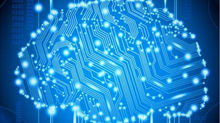The Science Behind Obtaining Brain Waves
Understanding EEGs
Can you say “electroencephalogram” five times, fast, without tripping up? I sure can’t, but fortunately I don’t need to pronounce it to explain how it works in this blog post!
Here’s your one sentence summary for what an electroencephalogram, or EEG, does:
Metal electrodes attached to your scalp detect your brain wave activity and transmit the data to a devices where it can be analyzed.
Unlike other methods, EEGs are noninvasive which means there is no surgery involved to attach electrodes to a patient’s head, but the data it procures can still help diagnose serious issues like epilepsy, sleep disorders, strokes, dementia, the presence of brain inflammation or tumors, and much more. EEGs also have very good temporal resolution, which means they obtain and then display changing brain information with a minimal time difference.
In a BCI, they’re an essential part of the system as without the collection of clean, reliable data from the human who’s trying to use their thoughts to control some computer mechanism, the entire pathway will become useless.
So let’s get technical.

Neurons and Electricity:
Our brains are made up of cells called neurons that communicate with each other, respond to stimuli our environment, and form the basis of our thoughts by exchanging information in the form of electrical pulses. At its core, electricity is a form of energy that arises from the flow of charged particles like ions and electrons. So, these electrical pulses are created when ions move cross the cell membrane, depolarizing and repolarizing areas along the cells in what is known as an action potential.
Although the electrical activity of individual neurons can’t be measured by electrodes placed on the scalp, overall changes in the brain’s electrical activity can be detected. More specifically, electrodes typically pick up on electrical activity that come from pyramidal cells when large numbers of them fire together and become synchronized. Pyramidal cells (pictured below, via Juan Gaertner and the Science Photo Library) are neurons in the cortical (outer) regions of the brains and have perpendicular orientations to the brain’s surface, so their overall electrical activity is the least distorted on the way from the brain through tissue, skull, and skin, to reach electrodes.

Electrodes
There are several ways that electrodes can pick up on these signals.
Wet electrodes typically use a gel to stick onto the head and aid in the transmission of brain waves. These electrodes can be made of silver, silver chloride, or other metals which are effective ionic conductors.
Dry electrodes directly touch the skin without the use of a gel, so they are less messy and faster to put on. However, the signals they receive may be less useful as they are more likely to become displaced and lose the signal and cannot pick up on higher frequencies.
The 10-20 international system for electrode placement offers a standardized template for the location of electrodes on a participants’ head, and these electrodes are usually placed around the head with the use of a headband or all over the head with the help of a cap.
Processing Data
While individual electrodes can pick up on electrical activity, we can’t truly understand the data until we put it in context. In fact, the data that an electrode picks up on is not the electrical activity of the brain only at that location. It’s actually the voltage, or electric potential difference, between the main electrode and reference/ground electrodes. Typical sites for the placement of the reference/ground electrodes include the tip of the nose or the earlobes since there is little to no electrical activity in these areas.
Unfortunately, the path that neurons’ electrical activity takes to reach electrodes is impeded by dead skin, oils, sweat, and others on the scalp which introduces resistance by substances that prevents electricity from easily passing. That’s why amplifiers which receive signals from electrodes and increase the output are so essential.

Amplifiers can be in different locations along this system. Traditionally, they existed on circuit boards, but since electrical activity is emitted by so many of our devices and power lines in everyday life, some of this activity would seep into the electrode wires and contaminate the data when amplified. Although it’s possible to use other processing techniques to remove this noise, active electrodes (pictured to the right, via OpenBCI) are becoming more popular. In these electrodes, the amplifiers are attached to the electrodes themselves to increase the data output at the source and reduce this interference. However, active electrodes are more expensive and can be bulky.
Data Transformations and Computers
After being amplified in either of these ways, the electrical signals must be transformed from this analog form of continuous data from the electrodes to a digital form with discrete data points that we can more easily interpret. This is done by A/D converters on a circuit board, which can have different sampling rates.
Sampling rates are the number of discrete points picked up on in a second. To determine optimal sampling rates, we use the Nyquist Theorem which essentially says that if the sampling rate is more than two times the highest frequency being picked up on the signal, then the digital data will adequately contain all of the features of the analog data.
Finally, the data can be sent from the circuit board to a computer for analysis through a wired connection or over bluetooth. At a computer, this data can be analyzed in many different ways and for different purposes, but a very common way of understanding EEG data is through what’s known as the Fourier Transformation.
Using just the raw EEG signal, data points can be plotted with time on the x-axis and voltage on the y-axis. Through the Fourier Transformation which compares raw data to sine waves and other math functions, the data can be plotted with frequency on the x-axis and voltage on the y-axis. This is useful because we better understand brain states in terms of the frequencies of the waves emitted from the brain, not voltages.

Picture of OpenBCIs GUI (software that visualizes EEG data) with Fourier Transformed data in the upper right
Wow, if you stuck around until the end, I’m really impressed with your passion for learning more about EEGs! Honestly, for me, the hardest part about writing this blog post was deciding how in depth to go for each critical part of the EEG system. I could probably write separate posts about each aspect, from the mechanics behind action potentials to A/D converters! And, of course, even beyond the steps I’ve discussed, there are so many more ways to obtain, process, and analyze EEG data for research or use in BCIs.
Let us know in the comments which aspects of a BCI you’d like to learn more about next!





















